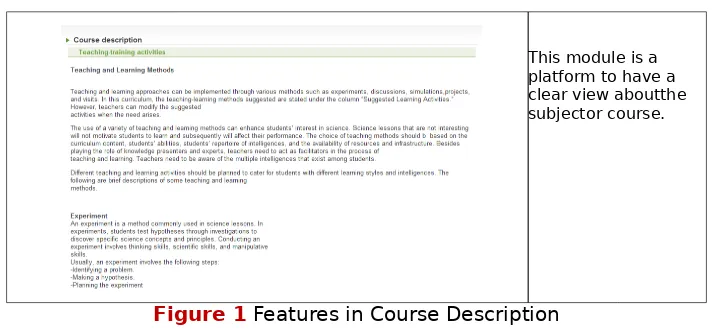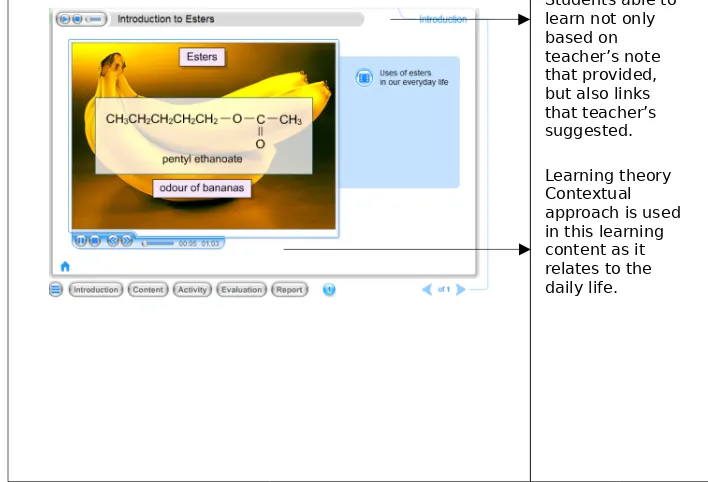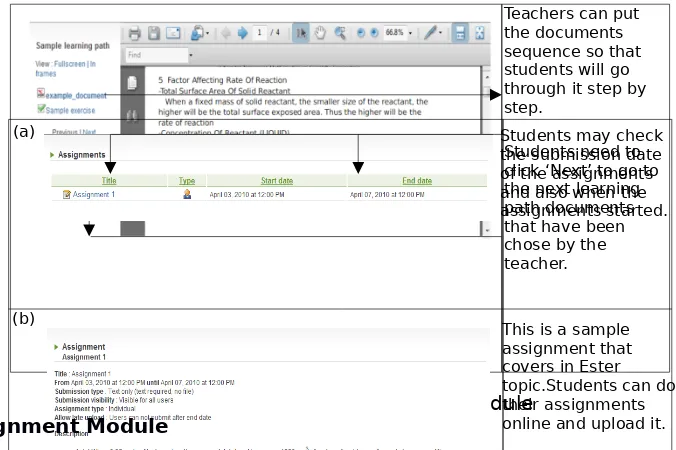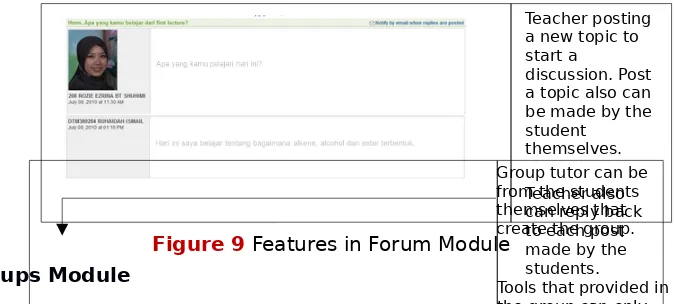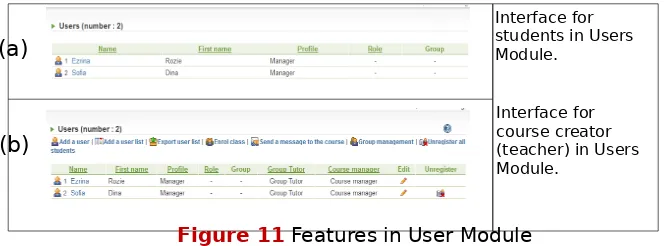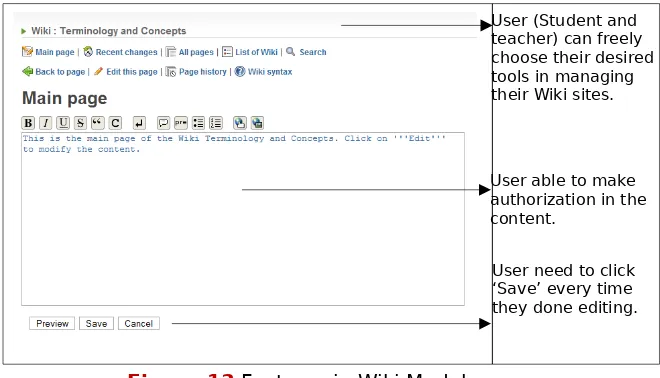The design of a Course Management System (CrMS) for
secondary school in Johor
Norasiken Bakar1, Rozie Ezrina Shuhimi2, Norshahidatul Hasana Ishak3, Kalthom Husain4
Faculty of Information and Communication Technology1, 2, 3 Department of Human Development4
Universiti Teknikal Malaysia Melaka (UTeM), MALAYSIA
Abstract
This research is involved with the development of a web based Course Management System to provide a platform, in learning and gaining knowledge in the field of Chemistry subject for secondary school. It is an alternative way for the students and teachers to communicate and create learning collaboration outside the classroom. The first objective of this research is to investigate the various types of systems to support e-learning. Second is to develop a Course Management System to secondary school in Johor, and the third objective is to evaluate the effectiveness, satisfaction on the modules and student’s acceptance of the system as a new alternative method in learning. Eventually, this web based learning system is developed by utilizing the Claroline open source e-learning software that was developed based on ADDIE (Analysis, Design, Development, Implementation, and Evaluation) model. It is believed that the developed CrMS is an approach to facilitate and enhance learning for personnel involved in Chemistry subject through computer and communication technology.
Norasiken, B. et al. (2012). The design of a Course Management System (CrMS) for secondary school in Johor, 12(1), pp. 5-15.
Introduction
This paper will explain an overview on designing of e-portal use for developing the prototype. This chapter will describe on the methodology that use, as well as details of what are researcher done during each phase of methodology used. Basically, this chapter provides overview of this CrMS development using ADDIE Model. ADDIE model is being adapted which a general model for the instructional design. ADDIE is a generic and simplified Instructional System Design model (Analysis, Design, Development, Implementation, and Evaluation), to reflect the professional organization of the instructional technology field (Peterson, 2003).
CrMS are web applications that run on a server and are accessed by using a web browser. Course Management System (CrMS) is a tool that focuses on the management of one or more courses, typically by an instructor, and is usually used for distance education or hybrid courses. CrMS give educators tools to create a course web site and provide access control so only enrolled students can view it. (Cole, Foster, 2007). CrMS have the capability of managing group discussion and to provide groups with document sharing and editing tools to engage students in completing group assignments and tasks. Group tools may support presenting final product of collaborative work and group activities. Example of group tool includes group posting areas, discussion forums, breakout sessions, chat areas, file exchange tools and group e-mail.
Course management systems can provide information on what students are doing when they are learning online, the length of time spent learning online, how active they are in their online courses, how they interact with others and how others interactions affect their actions (Laffey et al). With Course Management System, it provides instructional designers, developers, subject matter experts and authors to create and re-use learning content and reduce duplicated development efforts. Knowing the CrMS tools that students find most effective establishes an important
baseline for understanding student needs that can be addressed not only in a CrMS but also through other online systems and services (Johnson, 2008). According to Shankar (2007), Course Management System provides:
a) Online posting of course material.
Material such as reading copies and power point slides can be made available online, apart from the schedule of the course and its syllabus.
b) Learner assessment.
Learners can be accessed through online quizzes, tests and grade books.
c) Discussion forum.
Discussions can be conducted through a discussion board, where notes are exchanged and topics discussed between formal classroom sessions.
d) Communication.
Communication is carried through announcements to classes and other tools to communicate individually.
e) Allotment of lock boxes.
Learners can store class assignments, class notes or presentations in individual lock boxes.
f) Review of statistics.
The course statistics can be reviewed at will, which details information about who used the site and when.
For the purpose of this study, a Course Management System is defining as a software system that is specifically designed to teachers and students to use in teaching and learning. As education is gaining long term knowledge and supports long term classroom sessions, the term Course Management System in this research is the most suitable term to use.
Effectiveness, Satisfaction and Acceptance
This research will find out the effectivesness of the Course Management to students, their satisfaction in using Course Management System modules and their acceptance to the usability and functionality of the system. According to MsGraw-Hill Science & Technology dictionary, the term ‘effectives’ refers to a measure of the extent to which a system may be expected to achieve a set of specific mission requirements expressed as a function of availability, dependability, and capability. In this research, the term ‘effectiveness’ refers to system’s capability to enhance student’s result after using e-portal Course Management System in which it is tested according to student’s achievement in their posttest. While for the term ‘satisfaction’ and ‘acceptance’, according to American Heritage Dictionary, ‘satisfaction’ is refers to the fulfillment or gratification of a desire, need, or appetite, pleasure or contentment derived from such gratification, and a source or means of gratification while the word ‘acceptance’ refers to the act or process of accepting, the state of being accepted or acceptable, favorable reception; approval or belief in something; agreement. In this research, the word ‘satisfaction’ is refers to the student’s perception on the e-portal’s module that they will use to have learning process instead of using conventional method while the word ‘acceptance’ is refers to usability and functionality of the e-portal Course Management System in order to determine the system robustness to the secondary school.
CrMS Prototype Methodology Development
the development of this CrMS. The ADDIE model is short for five sequence states of the instructional design: Analysis, Design, Development, Implementation, and Evaluation. This model stress on elements such as teaching and learning objectives, prototype, usability and improvement. This model is further discussed in development steps involved.
Design phase consists of elements that need to have in the system so that it fulfill students and teachers requirement. It also involves outlining the strategy for how to reach the instructional goal determined during the Analysis phase. In this phase it focuses on the content selection, instructional strategy and method, media and material, and delivery system options. When planning a CrMS deployment, many concerns need to be addressed, but the two most important modeling determinations are the management of Web content data and the user communities that will be exposed to the data. Accommodations must be made to ensure that the CrMS content is not rendered improperly to the disparate user base, which could compromise an individual’s privacy. User profiles should be established so that content can be shown in proper user communities. This phase address this matters across all CrMS applications, content is exposed to its users in many forms, but the most prevalent forms of exposure include message boards, calendars, forums, and search utilities. For a CrMS to keep and increase their user bases, it need to maintain clear navigation flows so that end-users know where they are and where they are going to go next. If a design does not provide a proper navigation model, users may become confuse, lost interest, and ultimately browse somewhere else.
Besides, researcher decides to put on online with outside access and not limited to Local Area Network (LAN) in the schools only. Operational requirements focus on 24 hours and 7 days CrMS uptime so the students and teacher can use it at any time. During this phase, researcher also address on security issue. Security is usually one of the biggest concerns for any CrMS deployment process. As requested from target user which is students and also the teachers, researcher draws an authorization phases for each user so that how far can a user access and make alteration for the system can be limited. In addition, content and modules selection is also in focus as learning content that need to be previewed by the students are based on learning theory same goes to the selection of module. In this research, learning content is using Learning Content Management System from Ministry of Education at http://spp.moe.edu.my/ while all modules that are provided in Claroline are being used to test the student’s acceptance of all the modules afterward. Appendix 1shows design phase for development of CrMS while Appendix 2 shows the design of how a learning content of E-Government LCMS Portal interact with CrMS learning content be used in the CrMS.
In addition, this phase also stressed on design of each course, module, and lesson by detailing and scheduling activities, based on learning objectives. Researcher creates a master project plan based on documented scenarios, necessary customizations and content requirements. Each topic in the plan will be outlined in order to show the specific needs within the learning content area.
This module is a platform to have a clear view aboutthe subjector course.
Student can be alerted about important dates and agenda in this module.
They also can look forward for the upcoming events by clicking “>>” for next month or “<<” for the past event at previous month.
kinds of questions such as multiple choices, matching, and fill in the blanks. Besides, it enables teachers to track student’s results. ‘Forums’ module is a public discussion space divisible into topics (asynchronous conversation) or online discussion tool (synchronous conversation). It is a tool that enables learners to share information, discuss ideas and communicate for the purpose of collaboration. ‘Learning Path’ is to create complete sequence of learning activities. It is to stimulate the students to read documents. ‘Chat’ module enables students, teachers, and experts to have real time communication among them. It allows them to chat in a private chat room. ‘Group and User’ modules enable students to make a division into smaller groups which only selected person will only share some resources among members in the group for example from all sixty form five students in the school, they can manage their group based on their class only. ‘Wiki’ module acts as a platform where user can share same links to certain website so that they can share it with others, and it is not restricted to the teachers only.
Teachers are also can supervise students with the button ‘Statistic’ to track the tools used by the students and supervising the progression of the students. With all these modules, indirectly, collaborative learning activity implemented, where the learning activity involves more than one learner, which they can communicating with each other while having their online education.
Prototype
The prototype named e-portal is develop which consists of eleven modules which is Course Description, Agenda, Announcement, Document, Assignment, Exercise, Forum, Chat, Learning Path, Groups and User, and Wiki modules.
A. Course Description Module
Student can read details about subject or course in this module. They can also know the Qualification and goals of the subject, course content, support, methods of evaluation and others. Figure 1 shows features in Course Description interface.
B. Agenda Module
With agenda tool, teacher can provide information to the students about scheduled events linked to their course or subject. The events of the courses in which a user is enrolled show up in the ‘My Calendar’ section that gathers all the events in one document. Figure 2 shows features in Agenda Modules interface.
ISSN 1675 0292 8 Figure 1 Features in Course Description
Announcement module is the platform to students get latest information from the teacher.
Dates the post been publish will show at the top of the announcement.
Students can click at the file’s name or click ‘Download current directory’ to download the files given in their computer.
Students also can search for files they desire based on the keyword of the file’s name.
Students able to save file or open the file directly after clicking at the directory.
Figure 4 Features in Document Module
C. Announcement Module
Announcement module is the platform where teachers can display current information to the students and draw their attention to it. The teacher can remind an approaching deadline, point out new documents online, or communicate about an interesting conference. Figure 3 shows features in Announcement module interface.
D. Document Module
Document module provides a comprehensive mechanism for organizing files and links that a teacher would like to make available to the students. It is possible to make many directories, and to have directories within directories to enable grouping of files. It is a platform where students able to get links to any entity belonging to the course manager which in this research will be the teacher. It should be files, blog post, bookmarks and so on. Students can download the files or easily open it. Teachers also can create links to any websites as additional reference for students. In this research, researcher makes a links to Ministry of Education’s Learning Management System as additional learning material in order to vary the learning content. Figure 4 shows the interface of the module while Figure 5 shows the learning content in the module.
ISSN 1675 0292 9 Figure 2 Features in Agenda
Modules interface
Students able to learn not only based on teacher’s note that provided, but also links that teacher’s suggested.
Learning theory Contextual approach is used in this learning content as it relates to the daily life.
Figure 5 Learning Content links in Document Module from external websites (http://spp.moe.edu.my ) as learning
reference.
Students able to test their understanding via Exercise module.
The result will calculated
automatically after students click at Finish the test.
E. Exercise Module
Exercise module is a platform where students can do their exercises online. The exercise format can be multiple choice questions with unique answer, multiple choice questions with multiple answer, true/false question, fill in the blanks and matching question. Figure 6 shows features in Exercise module.
Teachers can put the documents sequence so that students will go through it step by step.
Students need to click ‘Next’ to go to the next learning path documents that have been chose by the teacher.
Figure 7 Features in Learning Path Module
Students may check the submission date of the assignments and also when the assignments started. (a)
(b)
(c)
This is a sample assignment that covers in Ester topic.Students can do their assignments online and upload it.
This is a sample answer that submitted from student.
Figure 8 Features in Assignment Module
F. Learning Path Module
The learning path module allows teachers to create a complete sequence of learning steps or activities that students can follow. This can stimulate students to read the documents. The main idea is that teacher themselves can suggest the sequence of documents, exercises, or follow learning activity that created. Figure 7 shows features in Learning Path Module.
G. Assignment Module
The Assignment module is a publication area for students. The teacher can create one or several assignments, where students will be able to publish their work. Publication can be a file, or a text, or a text and a file. It is also be made for a group instead for a single user. Students have the ability to modify their work after submission, and the course manager (teacher) can give them a feedback about their submissions. Figure 8 shows features in Assignment module.
ISSN 1675 0292 11 Figure 6 Features in Exercise
Teacher posting a new topic to start a
discussion. Post a topic also can be made by the student themselves.
Teacher also can reply back to each post made by the students. Figure 9 Features in Forum Module
Group tutor can be from the students themselves that create the group.
Tools that provided in the group can only be visible and access by the group members of the group.
Group members will be alerted with message if there is new message sent to the groups.
H. Forums Module
The forum module allows students and also teachers to post ideas, opinions, and any information in an organized way about the course. Posts are organized in a way that makes it easy for people to find the information they are interested in, but without having to wade through unrelated information. Teacher can post a new topic to start a discussion. Post a topic also can be made by the student themselves. At the same time, teacher and students may respond to the topic posted. This feature builds two ways communication between students and the teachers although they are outside the class. Figure 9 shows the forum created by the teachers and replies from the students.
I. Groups Module
A group is a collection of students under a label which is group name that share the same tools. The tools that they can share are forums, documents upload area, chat and Wiki tool. This tool allows teacher to compose sub groups of students from all of the students enrolled in the course. Figure 10 shows feature in Group module.
Interface for students in Users Module.
(a)
(b)
Interface for course creator (teacher) in Users Module.
User can read back their conversation in Chat Module till they log out the system.
This chat contents are only can be seen by the chatters only and not for public. User can see other online user and chat with them.
Figure 12 Features in Chat Module
J. Users Module
User Module allows students to look for their friends in the group that had been created. It is just a platform where students can see listing of members without authoring anything to the database for example at Figure 11 (a) while Figure 11 (b) shows interface for the teacher that has the authority to remove or add the member of the group.
K. Chat Module
The Chat module is a tool for online chatting. It enables student, teachers and also experts sending message while they are online. Students are also able to chat among peer groups. Users are able to see other online users in this module. Figure 12 shows features in Chat Module.
ISSN 1675 0292 13 Figure 10 Features in Groups
Module
Figure 13 Features in Wiki Module
User able to make authorization in the content.
User (Student and teacher) can freely choose their desired tools in managing their Wiki sites.
User need to click ‘Save’ every time they done editing.
L. Wiki Module
The Wiki module allows registered students to collaborative create, edit, link, and organize the content of a website for reference material. It is use to create collaborative website and to power community websites. These Wiki websites are often referred to as Wikis, for example Wikipedia. Figure 13 shows features is Wiki module.
Conclusion
In general, this part describes the designing and development of the prototype. Each part of the stages is important to complete the final prototype. There are five stage involved to complete the development of this project. The ADDIE model is a generic and simplified instructional systems design (ISD) model. ADDIE is short for Analyze, Design, Develop, Implement, and Evaluate. It is important to clarify and complete the stage in ADDIE to achieve the goals of the project. The research methodology is based on life cycle module for Course Management System (CrMS) that adapted from Norasiken (2008). The next chapter will discuss about the result gathered during the project.
Bibliography
Arulchelvan, S. (2012). "The Effectiveness of E-LMS on Performance of Indian Rural Schools: A Case from a Developing Country." Contemporary Educational Technology (3(1)): 1-16.
Claroline.NET. (2010).An eLearning and eWorking platform,A pedagogical model for eLearning, Tools to promote learning.
Don McIntosh, P. D. (2011) Vendors of Learning Management and E-learning Products For Trimeritus eLearning Solutions Inc.
Husain, K. S. (2012). "Performance Evaluation Process of the Content Management System: Case Study of Kau Marz System." Middle-East Journal of Scientific Research: 117-127.
Ion, A.M. (2012).Compared Analysis of Representative Learning and Content Management Systems used in Education. Informatica Economic,vol. 16.
Jason R.Cole, Helen F., (2007). Using Moodle: Teaching with the Popular Open Source Course Management System.
Johnson, B., & Christensen, L. (2008).Educational research: Quantitative, qualitative, and
Appendix 1 Design Phase Start
Analysis
Phase 2: Design
Learning sequence SCORM conformance Online education
Modules
Course Description Agenda
Announcement Documents Assignments Exercise Forums Chat
Groups and User Wiki
Design
End Evaluation Implementation
Development Learning
content Ester
Instructional strategy
Delivery system option
Modules selection System Security Authorization
Laffey, J., Stichter, J., & Schmidt, M. (2010).Social orthotics for youth with ASD to learn in a collaborative 3D VLE.Handbook of research on human cognition and assistive technology: Design, accessibility and transdisciplinary perspectives. New York: Idea Group.
McCarthy, J. (2010). Blended learning environments: Using social networking sites to enhance the first year experience. Australasian Journal of Educational Technology, 26(6), 729-740. Retrieved December 12, 2010 from http://www.ascilite.org.au/ajet/ajet26/mccarthy.html
Ozgur, H. Tosun, N. (2010).The Evaluation of E-Learning Material Prepared for Web-Based Training by Teacher Candidates. IODL&ICEM 2010, 6-8 October 2010. Peterson, C (2003). Bringing ADDIE to life: Instructional design at its best. Journal of
Educational Multimedia and Hypermedia, 12(3): 227-241. Shankar, V. (2007).CMS And LMS - A Comparison.
Si Fan (2011).Developing a Valid and Reliable Instrument to Evaluate Users’ Perception of Web-Based Learning in an Australian University Context. Paper presented at MERLOT Journal of Online Learning and Teaching
Appendix 2 CrMS launches courses develop by LCMS Import/
Convert
content Content development + learning theory stude nts teach
ers
CrMS
Content publishing / delivery
E-learning content repository Content creator
LCMS
Content repository
